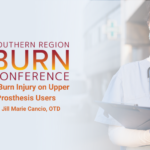Abstract | December 20, 2021
The Impact of Burn Injury on Upper Extremity Prosthesis Users
Learning Objectives
- Describe the impact of burn injury on upper extremity prosthesis users.
- Compare and contrast function outcomes of those who have sustained upper extremity amputation with and without concomitant burn injury.
- Discuss the unique rehabilitation challenges for those who have sustained upper extremity amputation and burn injury.
Introduction:
Burns with upper extremity (UE) amputation present a unique rehabilitation challenge. The purpose of this study of UE amputees who are active prosthesis users was to compare outcomes for those with and without burns.
Methods:
This is part of a larger nationwide study of U.S. military members and veterans with UE amputations. In-person data were collected at 5 sites. An therapist measured passive and active range of motion (PROM, AROM); administered the Quick Disability of the Arm, Shoulder, and Hand; Community Reintegration of Injured Service MembersComputer Adaptive-Test; Trinity Amputation and Prosthetic Experience Scale; healthrelated quality of life (VR-12); Activities Measure for Upper Extremity Amputees; Southampton Assessment Procedure; 9-Hole Peg Test; and Jebsen-Taylor Hand Function Test (JTHF); and recorded residual and phantom pain; timing of prosthesis receipt; and current prosthesis use. The IRB approved this study.
Results:
Data were collected on 126 individuals with UE amputation, of whom 105 had data on etiology and were included. Of these, 13 (12.4%) had burns (B) vs non-burn (NB). The majority were unilateral amputees (69% B, 90% NB). Most were transradial (TR) amputees (B 84.6%, NB 66.3%) as opposed to transhumeral (TH). A minority received their prosthetics within the first 3 months post-amputation (11.1% B, 28.8% NB) (p=0.15). Average age was 57.6 (SD 15.6) years for NB and 53.0 (20.6) years for B. Mean time since amputation was 22.5 (18.0) years for NB and 25.2 (17.3) years for B. The following non-significant differences in outcomes between B and NB were observed. Thirty-nine percent of B were employed full-time vs 18.9% of NB (p=0.15). The primary prosthesis was, for NB, a body-powered prosthesis (66.7%); for B, myoelectric (50%) or body-powered (50%). For unilateral UE amputees, there were no differences between B and NB on performance testing for dexterity and functional tasks or in self-reported disability, quality of life or prevalence or intensity of pain. B trended towards more moderate to severe PROM deficits with shoulder forward flexion (TH B 50%, TH NB 23.1% [p=0.444]; TR B 20%, TR NB 5.6% [p=0.197]) and shoulder abduction (TH B 50%, TH NB 26.9% [p=0.497]; TR B 30%, TR NB 16.4% [p=0.376]). Also, TR amputees with burns trended towards more PROM deficits with elbow flexion (B 20%, NB 6.9% [p=0.212]) and elbow extension (B 20%, NB 8.6% [p=0.272]). AROM deficits also trended greater in B.
Conclusions:
We did not observe differences in physical function, pain levels, or quality of life between those with and without burns. Further studies with larger samples are needed, to include analysis of burn location, burn size, hospital length of stay, and rehabilitation care.

